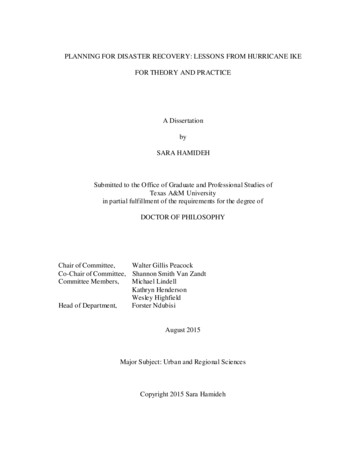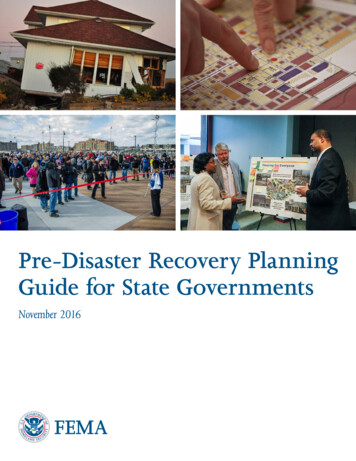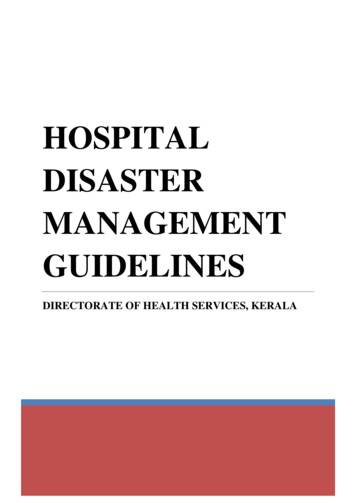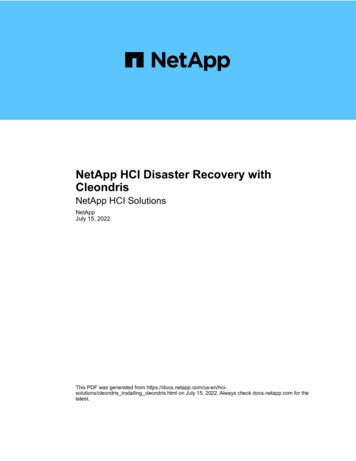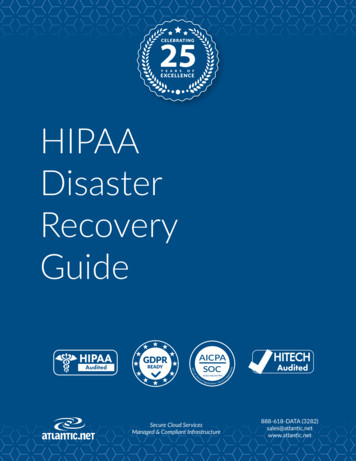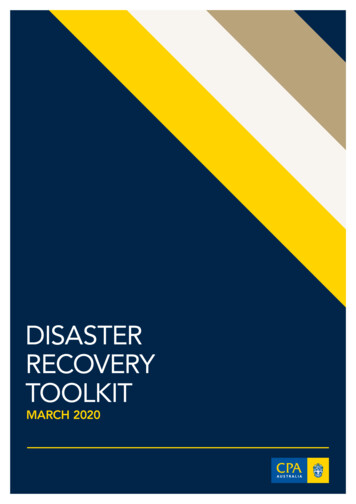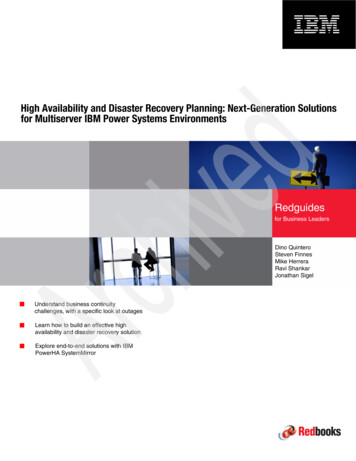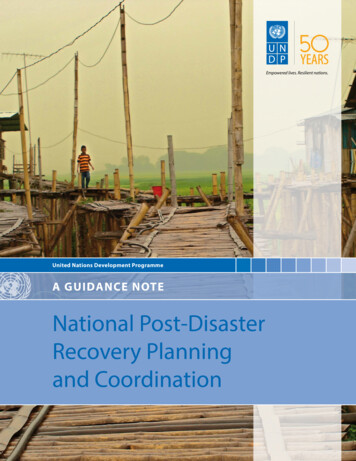
Transcription
Empowered lives. Resilient nations.United Nations Development ProgrammeA GUIDANCE NOTENational Post-DisasterRecovery Planningand Coordination
AcknowledgementsThe preparation of this Guidance Note on “NationalPost-Disaster Recovery Planning and Coordination” wascoordinated by the Climate Change and Disaster RiskReduction Cluster of the Bureau for Policy and ProgrammeSupport (BPPS) of UNDP - New York. The authoring teamincludes: Angeles Arenas, Rita Missal, Chiara Mellucci,Zubair Murshed, Krishna Vatsa and independent DisasterRisk Reduction experts Monica Trujillo and Laura Olson.The authors wish to thank the colleagues whose expertiseand inputs were integral to the development of thisGuidance Note, particularly the following colleagues fromUNDP country offices: Seeta Giri (UNDP Bangladesh), TitusKuuyuor (UNDP Mozambique), Muyiwa Odele (UNDPNigeria), Rocio Chain (UNDP Bolivia) and Christian BudiUsfinit (UNDP Indonesia). In addition to colleagues fromcountry offices, we would like to thank colleagues fromUNDP Headquarter Bureaus, namely, the Crisis ResponseUnit (CRU), the Bureau for Policy and Programme Support(BPPS) and the Bureau for Management Services (BMS),who reviewed and provided valuable inputs to finalize thedocument.The document builds on the experiences of selectedcountries, which include Bangladesh, Bolivia, Chile,Dominican Republic, Haiti, Indonesia, Maldives, Pakistan,Philippines and Tajikistan. Creation of the documentfollowed a thorough and extensive review process withCountry Offices, practitioners and colleagues.For more information or to participate infurther discussions, Country Offices canconsult the Guidance Notes section of theUNDP Crisis Response website.
Table of ContentsOverview of the Guidance NoteIntroductionSummary and Structure of the Guidance Note568PART A: Support to Governments111. The Conceptual Framework1.1 What is Post-Disaster Recovery?1.2 Some Useful Definitions of Disaster Recovery1.3 From Theory to Practice: UNDP and Sustainable Disaster Recovery121212122. Areas of Support to Governments2.1. Institutional Arrangements for Recovery2.2. Needs Assessments2.3 Recovery Planning: National and Sectoral Recovery Frameworks2.4 Managing Recovery2.5 Building Back Better and Managing Residual Risks2.6 Resource Mobilization15151922303638PART B: UNDP Management451. Country Office Management1.1 Internal Country Office Management and External Coordination1.2 Management and Implementation Arrangements with Partners1.3 Re-Orientation of the Programme Portfolio1.4 Communications Strategy47474749522. Support Services From Headquarters2.1 Surge Support and Expres Roster Services2.2 The Fast-Track Mechanism2.3 UNDP Financial Resources545455573. The Formulation of Projects3.1 Project Design3.2 Joint Programmes626264Annexes67Annex 1: Project Document TemplateAnnex 2: Example of a Results and Resources FrameworkAnnex 3: Examples of Disaster Risk Reduction in RecoveryAnnex 4: Lessons LearnedAnnex 5: Sample Template and Guidance for Overarching Recovery StrategyAnnex 6: Crisis Response Focal Point ChecklistAnnex 7: Bangladesh NGO Contracting ProcessAnnex 8: Commonly Used AcronymsReferences68768082859499100102
Overview of theGuidance Note
Overview of the Guidance NoteINTRODUCTIONNearly half of the countries where UNDP works are proneto conflict, disasters, political instability and economicshocks. UNDP assists countries that are addressingsudden and slow-onset events that destabilize economiesand communities by supporting their governments asthey move out of the crisis response phase and into theplanning and implementation of longer-term recoveryactivities. As one of the few partners with a mandateand a permanent presence on the ground before, duringand after a crisis, UNDP is well positioned to take actionat the onset of crises to establish a clear link betweenhumanitarian activities, recovery planning and thetransition to sustainable development pathways. Dueto its experience in development policy and practice,UNDP can play a strategic role in efforts to integratedevelopment principles into recovery processes, lookingbeyond the idea of restoring the status quo to a visionof building communities back better, reducing povertyand vulnerability, protecting and quickly restoringdevelopment gains and reducing the risk of future eventsby adopting strategies that transform risk into resilience.The importance of UNDP’s work on recovery is increasingas the number of people affected by disasters around theworld continue to rise. Changing temperatures, extremeweather patterns, variations in precipitation and risingsea levels are modifying hazard levels and exacerbatingdisaster risks. The frequency and intensity of weatherrelated events are expected to increase, with heat waves,drought, flooding, cyclones and wildfires exacting aheavier toll on human and natural environments. Acrossthe globe, these threats, when combined with poverty,exposure, continued urban migration and the destructionof natural ecosystems, drive risk to dangerous andunpredictable levels.From 2012 to 2014, 994 disasters impacted more than326 million people across the globe.1 The cost of physicaldamage caused by these events is also rising - from anestimated US 20 billion on average per year in the 1990sto about 100 billion per year in the first decade of thiscentury2. As climate change and migration accelerate, thecost of recovery will continue on an upward trajectory.Recovery strategies that champion inclusive, safe, resilientand sustainable rebuilding and more equitable societiesare in short supply and high demand.Recovering from disasters is a challenging process.Disasters undermine hard won development gainsand create greater pressures than are found in ‘normal’development settings: heightened urgency; the needfor rapid reaction and speedy results; media scrutiny;lack of experience, capacity and expertise; a multiplicityof national, local and international actors whose effortsall require coordination; and resource scarcity and fewdedicated funding sources to meet recovery needs.Responding to these demands requires a clear road map,an efficient, well-organized process, knowledge gainedfrom past failures and successes, rapid decision-makingand implementation capabilities and skilled coordination.The main objective of this Guidance Note on National PostDisaster Recovery Planning and Coordination is to providepractical advice to UNDP Country Offices on how to designand implement recovery initiatives that will strengthengovernment capacity to lead and manage nationalrecovery efforts in the early, medium and long-term.1Centre for Research on the Epidemiology of Disasters (CRED). 2014. Annual Disaster Statistical Review 2013: The numbers and trends. Institute ofHealth and Society (IRSS) Université Catholique de Louvain – Brussels, Belgium.2IMF. 2012. Natural Disasters: Mitigating Impact, Managing Risks.6 A GUIDANCE NOTE
This document emphasizes all three phases of disasterrecovery and the need to understand that much like indevelopment work, there are no quick fixes in recovery andconcerted efforts to rebuild sustainable societies requirelong-term investments.This Guidance Note will help Country Offices as they positionUNDP’s support to host governments in the wake of a majordisaster and through the entire recovery process so thatsustainable disaster recovery strategies can be deliveredeffectively at the country level.The UNDP Mandate in RecoveryUNDP’s mandate to conduct operational activities in disaster mitigation, prevention andpreparedness was laid out by the United Nations General Assembly in 1997 (A/RES/52/12B,paragraph 16, December 1997) and an additional mandate to ensure inter-agency recoverypreparedness was added by the United Nations Emergency Relief Coordinator in 2006. Withinthe scope of these mandates, UNDP has provided sound leadership in the field of disasterrecovery for many years, which includes leadership in assessment, planning, programming,coordination and capacity building. UNDP champions the need to credibly address EarlyRecovery in humanitarian contexts and chairs the Cluster Working Group on Early Recovery.National Post-Disaster Recovery Planning and Coordination 7
Overview of the Guidance NoteS U M M A RY A N D S T R U C T U R E O F T H E G U I DA N C E N OT EThis Guidance Note draws on UNDP’s extensive experiencein supporting governments during post-disaster recoveryprocesses and it capitalizes on particular areas of expertisethat have been developed, such as post-disaster needsassessments (PDNAs), design of national recoverystrategies and institutional arrangements for recovery,coordination of recovery processes, government capacitydevelopment and the restoration of local governancefunctions. Lessons learned and best practices that informUNDP’s approach to recovery are drawn from countries’experiences in recovery, including those listed below.Bangladesh – In 2007, Cyclone Sidr took nearly 4,000lives and left millions homeless. Bolivia – Flooding in 2006caused 260 million in damage and affected more than38,800 families.Chile – An 8.8 magnitude earthquake and tsunami inSouth Central Chile in 2010 caused damage estimated atmore than 30 billion.3Dominican Republic – Tropical storms Noel andOlga in 2008 caused more than 439 million in damageand had both direct and indirect effects on more than 70percent of the country’s population.Haiti – The 2010 earthquake in Haiti had a devastatingimpact on the country and particularly on Port au Prince.Indonesia – The South Asian Tsunami that struck Acehand the island of Sumatra in December 2004 was followedby an earthquake in March 2005. In May 2006, anotherearthquake struck Central Java and the Special Region ofYogyakarta Province.4Maldives – The 2004 Asian Tsunami caused thiscountry’s gross domestic product to drop by more than 60percent and affected one-third of the population.Pakistan – Monsoon floods in July through September2010 affected the lives of over 18 million people and forcedmillions to flee their homes.5Philippines – In 2013, Typhoon Yolanda – one of thestrongest typhoons on record – caused extensive loss oflife and damage to housing, livelihoods and infrastructureacross nine of the Philippine’s poorest provinces, affecting16.1 million people and displacing 4.1 million.Tajikistan – 2007-2008 brought a series of economic,environmental and social shocks which became acompound disaster,6 affecting two million people andcreating massive food insecurity and damage to water andelectrical supplies.This Guidance Note draws upon the experience of theseUNDP Country Offices as they sought to design andimplement recovery programmes in a wide range of areasthat span across UNDP’s areas of expertise. Their recoveryinitiatives were reviewed to extract practical insightsand critical lessons capable of informing future recoveryprocesses. These experiences differ in terms of context,scale of destruction, national and local capacities andcharacteristics in each setting, but together they highlighta range of good practice examples, potential interventions,challenges and pitfalls.3UNDP. Chile Country Case Study: Support to Early Recovery in the aftermath of the Earthquake in Chile in February 2010.4UNDP. Indonesia Country Case Study: Early Recovery Assistance Programme for Yogyakarta and Central Java.5UNDP. Pakistan Case Study: Early Recovery Programme for the flood affected communities in Pakistan.6UNDP. Tajikistan Country Case Study: Early Recovery Roll Out.8 A GUIDANCE NOTE
The Guidance Note on National Post-Disaster RecoveryPlanning and Coordination functions as a manual forUNDP Country Offices and staff. Part A outlines theprincipal areas of expertise and types of support UNDPcan provide to governments: institutional arrangementsand coordination mechanisms for recovery; conductingneeds assessments; recovery planning; the concept ofDisaster Risk Reduction and ‘building back better’; resourceMobilization; managing recovery processes; and residualrisk (such as preparedness measures and pre-disasterrecovery planning). Part B focuses on UNDP’s internalprocesses and operational procedures and describes theessential considerations and steps that UNDP CountryOffices must take in order to comply with programmingrequirements, procurement regulations, proposal writingformats, etc. that are used in UNDP’s post-disaster recoveryplanning process.As UNDP continues to engage in national post-disasterrecovery planning and coordination, this Guidance Notewill be continually updated so that it remains a ‘living’document and constitutes a vital knowledge managementresource in a learning organization. To make a contributionto the Guidance Note, or submit questions, e-mailsignature.products@undp.org.The Guidance Note on National Post-Disaster RecoveryPlanning and Coordination is one of a series of UNDPGuidance Notes, that include: ‘Emergency Employment and Enterprise Recovery’,‘Community Infrastructure Rehabilitation’,‘Debris Management’,‘Municipal Solid Waste Management’,‘Restoration of Local Governance Functions’, and‘Aid Management’.In particular, this Guidance Note complements the‘Restoration of Local Governance Functions’ and ‘AidManagement’ guidance notes. While this Guidance Notedoes not discuss every area of UNDP’s work on recovery, allthe other Guidance Note also have some bearing on thisdocument.National Post-Disaster Recovery Planning and Coordination 9
Lugar: San Francisco de Quito (Provincia de Pichincha)Fecha: 10 de agosto del 2008Quito es la capital de la república del Ecuador. Situada a 2850 metros sobre el nivel del mar, fue la primera ciudad declarada Patrimonio Cultural de la Humanidad por la Unesco. Situada en un valle en la falda del volcáPichincha, se extiende de manera alargada por el tramo occidental de los Andes septentrionales ecuatorianos2
PA R T A :Support toGovernments
PART A: Support to Governments1THE CONCEPTUAL FRAMEWORK1.1. What is Post-Disaster Recovery?Disaster Management consists of five main phases:prevention, preparedness, response, mitigation andrecovery. While significant knowledge exists on the firstfour phases, the recovery phase remains less developedand is the least well understood. UNDP sees recovery as anopportunity for change and for connecting countries to theknowledge, experience and resources needed to transformplaces where extreme events occur, enabling resilient andsustainable outcomes for the affected populations.1.2. Some Useful Definitions of DisasterRecoveryRecovery is the restoration, and improvement whereappropriate, of facilities, livelihoods and living conditions ofdisaster-affected communities, including efforts to reducedisaster risk factors.- UNISDR, 2007, www.unisdr.org/we/inform/terminologyRecovery is not just a physical outcome but a socialprocess that encompasses decision-making about restorationand reconstruction activities The post-disaster period is anopportunity to upgrade the quality of construction to betterresist subsequent events and begin to think through waysto mitigate future damage Disasters should be viewed asproviding unique opportunities for change—not only tobuilding local capability for recovery—but for long-termsustainable development as well.- Mileti, 1999, pp. 229, 236, 238Early Recovery addresses recovery needs during thehumanitarian phase. It is an integrated, inclusive andcoordinated approach to gradually turn the dividendsof humanitarian action into sustainable crisis recovery,resilience building and development opportunities. Usingan early recovery approach is crucial to the first efforts ofthe community to recover and build their resilience. Such12 A GUIDANCE NOTEan approach could include restoring local governmentcapacities, reviving livelihoods, strengthening basic socialservices, addressing social cohesion and community securityconcerns. (from the internal document ImplementingEarly Recovery: Background note for IASC Principals,Recommendations on Strengthening Early Recovery.- Global Cluster on Early Recovery, 5 September 20141.3. From Theory to Practice: UNDP andSustainable Disaster RecoveryFor UNDP, recovery efforts begin in the immediateaftermath of a crisis - during the relief phase itself - andcontinue until full recovery is achieved. UNDP’s approachinvolves planning for recovery in stages – which arereferred to as early, medium and long-term recovery.Early recovery takes place during a transition period thatrepresents a vital bridge between emergency relief andlonger-term development. Early recovery begins withquick interventions, such as Cash for Work or Food forWork; in the medium-term, interventions aim at rebuildingshelter, infrastructure and livelihoods; and in the long-terminterventions work toward building government capacitiesand reducing the risk of future disasters. However, activitiesto support national government efforts to coordinate andplan recovery could already take place in the early daysafter the disaster - even in the humanitarian phase - andcontinue until the end of the recovery period.Recovery aims to restore basic services and facilities,economic stability, physical assets, infrastructure,important socio-cultural and environmental featuresof communities and living conditions. Fundamentalto UNDP’s conceptual framework for recovery is theapplication of principles that reduce the risk of futureevents, decrease the vulnerability of impacted populations,promote ‘building back better’ 7 and ensure thesustainability of recovery efforts.
Recovery encompasses a huge range of activities, andsuccessful recovery efforts require excellent coordinationacross an array of sectors and partners in the process.Recovery processes should be led by national and localgovernments and their sector ministries and agencies withsupport from international humanitarian and developmentorganizations, United Nations agencies, civil societyorganizations and non-governmental organizations.In the midst of this wide variety of actors and interestssupporting recovery, it is particularly important thataffected communities are provided the space to participatein local rebuilding processes and are able to represent theirpreferences and vision for their lives, future safety and wellbeing. Inclusive processes, which give affected populationsa voice in the planning, design and implementation ofrecovery efforts, have been shown to produce greatersuccess, higher satisfaction and sustainable outcomes andare championed as part of the UNDP approach.Part I of this Guidance Note provides guidance on themain elements of the post-disaster recovery process, asreflected in the diagram below. Past experience showsthat these elements present challenges to governmentsand to the international community when implementingrecovery processes and therefore require careful attentionand strong support. UNDP has developed particularexpertise in these principal areas and can effectively buildthe capacity of governments to lead efforts to assess theimpact of a disaster, identify needs, prioritize interventionsand coordinate the implementation of recovery processes.Principal Areas of Support to Governments in Recovery Planning and CoordinationInstitutionalArrangementsfor Recovery7Post coveryBuidling BackBetter andManagingResidual RisksResourceMobilizationISDR. 2009. Terminology on Disaster Risk Reduction; EU, UN, WB. 2013. Post-Disaster Needs Assessment Guide: Volume A.National Post-Disaster Recovery Planning and Coordination 13
PART A: Support to Governments1THE CONCEPTUAL FRAMEWORKPost-disaster recovery should be governed by guiding principles,examples of which are listed below.8 Ground recovery interventions in athorough understanding of the context inwhich they take place. Identify needs and priorities of affectedpopulations by creating participatoryprocesses that involve communitiesthemselves in decision-making, servicedelivery and recovery. Promote gender equality and ensurerecovery needs of women, children andmen are met across all sectors. Assess vulnerability to non-recovery,based on factors such as race, gender,ethnicity, age, language, religion, politicalor other affiliation, national or social origin,disability, geography, poverty, etc. Integrate principles of development andsecure human development gains. Support spontaneous recovery processes,local networks, volunteerism and selfsufficiency. Ensure national ownership and leadershipof the recovery process through the fullest8possible engagement of national and localauthorities in the planning, execution andmonitoring of recovery actions. Rebuild people’s livelihoods to ensuretheir capacity to recover and promote theacquisition of new livelihoods, taking thespecific needs of women into account. Support decentralized decision-makingand management of recovery; build localnational coordination. Strengthen monitoring systems andincrease transparency so that affectedpopulations can hold governments andlocal authorities accountable for recoveryoutcomes. Integrate measures that reduce risk andvulnerability, prevent conflict and buildback better. Safeguard primum non nocere – ‘first, do noharm’ - in recovery interventions. Promote human rights and other rightsbased approaches in recovery.CWGER. 2008. Guidance Note on Early Recovery; EU, UN, WB. 2013. Post-Disaster Needs Assessment Guide: Volume A.14 A GUIDANCE NOTE
2AREAS OF SUPPORT TO GOVERNMENTSWith experience of working both in crisis and development 2.5. Building Back Better and Managing Residual Riskscontexts, UNDP is particularly well positioned to play a main 2.6. Resource Mobilizationrole in post-disaster recovery, minimizing the possible dividebetween relief and development. Additionally, decades ofexperience in the implementation of programmes in disaster 2.1. Institutional Arrangements forrisk reduction and post-disaster recovery in over 177 countries, Recoveryhas afforded UNDP considerable expertise in this area.One of the most critical elements of post-disaster recoveryExperience shows that post-disaster recovery is aplanning is to define the institutional arrangements forchallenging process characterized by urgency, a multiplicity recovery. Given the numerous national and internationalof national and international actors, and limited amountsactors involved in a multi-sectoral recovery process,of capacity, expertise and funding. Additionally, thecoordination, strong leadership and the capacity to acttransition between the humanitarian and recovery phasebecome central to effective recovery management processes.is particularly challenging as it often results in gaps inservice delivery, programming and decision-making asInstitutional arrangements in recovery refers to thehumanitarian actors phase out and recovery activities rundesignation of roles and responsibilities within theby development actors phase in. It is therefore essentialgovernment to lead recovery and reconstruction. Theto manage this transition well and plan for it early in orderprincipal elements of institutional arrangements areto avoid interruptions in assistance and support to thethe nomination of national and sub-national structuresto govern recovery; establishing legal mandates forimpacted populations.implementing agencies; identifying technical skills andMeeting the demands of this situation requires strongcapacities; securing finances and allocating resources;leadership, coordination and planning - all areas in whichdefining coordination mechanisms; and appointingUNDP can provide critical advice to government partnersoversight functions. Another part of strong institutionaland can offer expertise to help strengthen their capacityarrangements is a system for monitoring activities,to lead effectively in this context. UNDP makes its maintracking funds and evaluating projects and programmes.contribution to recovery through the capacity and expertise Furthermore, the manner in which funds for recoveryfound in its Country Offices, which are augmented through are mobilized, how they flow and assurances of bothsupport from regional centres and headquarters, whentransparency and accountability, will be paramount to therequired. Therefore, UNDP Country Offices must be actively success of any set of institutional arrangements.engaged in the post-disaster environment and prepared toshoulder organizational recovery mandates.While a variety of options for setting up institutionalarrangements for recovery exist, three importantThis section of the Guidance Note outlines the waysconsiderations for this process are:in which UNDP can provide practical support to hostgovernments in the following areas:1. Can line ministries be strengthened to lead recovery ineach sector? 2.1. Institutional Arrangements for Recovery2. Does a lead agency or institution need to be created? 2.2. Needs Assessments 2.3. Recovery Planning3. Is a new but temporary lead agency best for governance 2.4. Managing Recoveryarrangements in the host country?National Post-Disaster Recovery Planning and Coordination 15
PART A: Support to Governments2AREAS OF SUPPORT TO GOVERNMENTSEarly establishment of the best mechanisms to managerecovery will allow effective implementation and clear linesof authority so that recovery objectives can be met. Strongleadership capacities can overcome institutional barriers,organizational divisions between stakeholders, align allplayers behind a single set of recovery objectives andensure that best practices are incorporated into recoverythinking and practice.The role of the recovery agency should include the itemslisted below.1. Provide leadership and direction to all rebuilding effortsof national and international assistance agencies.2. Formulate national needs assessments, priorities, anational recovery plan, policies and legal or regulatorychanges required to support disaster relief, recoveryand risk reduction measures.3. Facilitate formulation of sectoral recovery strategies,financing, and project approval processes.4. Review and select projects and programmes andidentify appropriate agencies and partners to executeand facilitate project implementation in disaster relief,recovery and risk reduction.5. Facilitate coordination of recovery efforts at localgovernment level and empower local leadership intheir interactions with national ministries and withinternational and national non-governmental partners.6. Mobilize, define the use of, and manage nationalgovernment and international donor funding supportand resources behind national relief, recovery,reconstruction and risk reduction goals.7. Conduct oversight (monitor and evaluate) of recoveryand reconstruction efforts of various government andother implementation agencies in terms of project successand timelines, speed of reconstruction, processes, funddeployment, transparency, accountability and benefitsaccruing to affected communities.While national governments need to define, lead, planand coordinate overall recovery, local governments mustcontribute to detailed project planning based on therequirements of local communities. The internationalcommunity and development actors must work tostrengthen local governance mechanisms - includingcivil society organizations, NGOs, women’s organizationsand community-based organizations - to allow broadparticipation in the recovery process, provide essentialtechnical advice and encourage transparency andaccountability of governance processes.While these national institutional arrangements are beingset up, the UNDP Country Office can support the recoveryinstitutions with technical experts and correspondingsupport services, such as offices, equipment, humanresources, go kits, etc., to strengthen the institution’scapacities to plan and implement recovery.For more information on institutional arrangementsfor post-disaster recovery, see the Guide to DevelopingDisaster Recovery Frameworks, which has been developedas part of the PDNA process and contains a chapter called“Institutional Framework for Recovery” (pp. 25-39).9 Thisguide, jointly developed by UNDP, the World Bank’s GlobalFacility for Disaster Reduction and Recovery (GFDRR)10 andthe European Union, is an excellent resource that details themany issues that must be contemplated and resolved whendesigning functional institutional arrangements capable ofsupporting successful recovery operations in a country.9Full guide (dated March 2015): is-prevention-and recovery/pdna.html.10The Global Facility for Disaster Risk Reduction (GFDRR) is a global partnership, managed by the World Bank and funded by 25 donor partners, to helphigh-risk, low-capacity developing countries better understand and reduce their vulnerabilities to natural hazards and adapt to climate change.16 A GUIDANCE NOTE
Institutional Arrangements for RecoveryUNDP Pakistan’s Support to EarthquakeReconstruction and RehabilitationAuthority (ERRA)Following the 7.6 magnitude earthquake inKashmir in 2005, the Government of Pakistanset up a dedicated agency, the EarthquakeReconstruction and Rehabilitation Authority(ERRA), to manage and coordinate thecountry’s earthquake recovery processes.Over a three year period, UNDP with fundsfrom the Government of Germany and DFID,supported this agency. UNDP initially workedwith the ERRA to identify and recruit nationaland international experts to lead sectoralrecovery work, provided technical assistancefor projects and gave equipment to set upthe institution. UNDP also funded positionswithin the agency at the national and districtlevel to support government coordinateand oversee implementation of recoveryprogrammes in housing, livelihoods, legalaid, education, etc. UNDP’ contributed to thefunctioning of ERRA as a strong technicalentity with clear operating procedures.Indonesia’s Institutional CoordinationMechanism Established in 2005Following the 2004 Asi
Post-Disaster Recovery Planning and Coordination" was coordinated by the Climate Change and Disaster Risk Reduction Cluster of the Bureau for Policy and Programme Support (BPPS) of UNDP - New York. The authoring team includes: Angeles Arenas, Rita Missal, Chiara Mellucci, Zubair Murshed, Krishna Vatsa and independent Disaster

